Optical super-multiplexing by polyynes
a technology of optical super-multiplexing and polyynes, applied in the direction of nanosensors, microorganism testing/measurement, biochemistry apparatus and processes, etc., can solve the problem of more than 2000 optical barcodes, requiring complicated optical setup and spectral un-mixing, and limited number of resolvable features for fluorescence detection. to achieve the effect of multiplexing live cells
- Summary
- Abstract
- Description
- Claims
- Application Information
AI Technical Summary
Benefits of technology
Problems solved by technology
Method used
Image
Examples
example 1
[0243]All reagents and solvents were purchased from Sigma-Aldrich and Fisher Scientific and were used without further purification, unless otherwise stated. Flash chromatography was performed on silica gel (Silicycle, 40-63 μm). TLC was performed on 5 mm E. Merck silica plates (60F-254) and visualized by UV light or potassium permanganate (KMnO4) or ceric ammonium molybdate (CAM) stain.
[0244]Nuclear magnetic resonance (NMR) spectra were recorded on a Bruker 500 (500 MHz) Bruker 400 (400 MHz) Fourier Transform (FT) NMR spectrometers at Columbia University, Chemistry Department. NMR spectra were calibrated using residual undeuterated solvent (1H: δ 7.26 for CDCl3, δ 3.31 for MeOH-d4, δ 2.50 for DMSO-d6; 13C: δ 77.16 for CDCl3, δ 49.0 for MeOH-d4, δ 39.50 for DMSO-d6). The following abbreviations were used to explain multiplicities: s=singlet, d=doublet, t=triplet, q=quartet, m=multiplet, br=broad. High resolution mass spectra (HRMS) were recorded on a XEVO G2-XS Waters mass spectromet...
example 2
d Raman Scattering (SRS) Microscopy
[0354]An integrated laser system (picoEMERALD, Applied Physics & Electronics, Inc.) is used to produce two synchronized laser beams at 80 MHz repetition rate. A fundamental Stokes beam (1064 nm, 6 ps pulse width) is intensity modulated at 8 MHz by an electro-optic-modulator with >90% modulation depth, and a tunable pump beam (720-990 nm, 5-6 ps pulse width) is produced by a build-in optical parametric oscillator. The pump and Stokes beams are spatially and temporally overlapped using two dichroic mirrors and a delay stage inside the laser system, and coupled into an inverted laser-scanning multiphoton microscope (FV1200MPE, Olympus) with optimized near-IR throughput.
[0355]The lasers are focused on the sample through a 25× water objective (XLPlan N, 1.05 N.A. MP, Olympus) or a 60× water objective (UPlanAPO / IR, 1.2 N.A., Olympus) with high near-IR transmission. The beam sizes of pump and Stokes laser are adjusted to match the back-aperture of the obj...
example 3
Antibody Conjugation with 4-yne NHS Ester
[0360]Goat-anti-Rabbit secondary antibodies (2 mg / mL, Millipore, AP132) are adjusted to pH-8.3 with sodium bicarbonate solution. 50 μL 4 mg / mL 4-yne NHS ester in DMSO solution is added dropwise to 250 μL protein solution while stirring. Reaction is kept under gentle stirring at RT for 1 h. The labeled antibodies are purified using gel permeation chromatography with Sephadex® G-25 (Sigma, G25150). Sephadex® G-25 gel is first swelled in PBS buffer at 90° C. for 1 h and settled down at room temperature. The gel is then exchanged with fresh PBS buffer and stored at 4° C. For gel chromatography, the column (diameter ˜1 cm and length >12 cm) is loaded with swelled gels and equilibrated with PBS buffer. The antibody solution is applied and eluted with PBS. The first band with light color for 4-yne conjugated antibodies is collected. The solution is centrifuged briefly and the supernatant is concentrated using Amicon® Ultra Centrifugal Filters (Milli...
PUM
| Property | Measurement | Unit |
|---|---|---|
| diameter | aaaaa | aaaaa |
| diameter | aaaaa | aaaaa |
| diameter | aaaaa | aaaaa |
Abstract
Description
Claims
Application Information
 Login to View More
Login to View More - R&D
- Intellectual Property
- Life Sciences
- Materials
- Tech Scout
- Unparalleled Data Quality
- Higher Quality Content
- 60% Fewer Hallucinations
Browse by: Latest US Patents, China's latest patents, Technical Efficacy Thesaurus, Application Domain, Technology Topic, Popular Technical Reports.
© 2025 PatSnap. All rights reserved.Legal|Privacy policy|Modern Slavery Act Transparency Statement|Sitemap|About US| Contact US: help@patsnap.com



